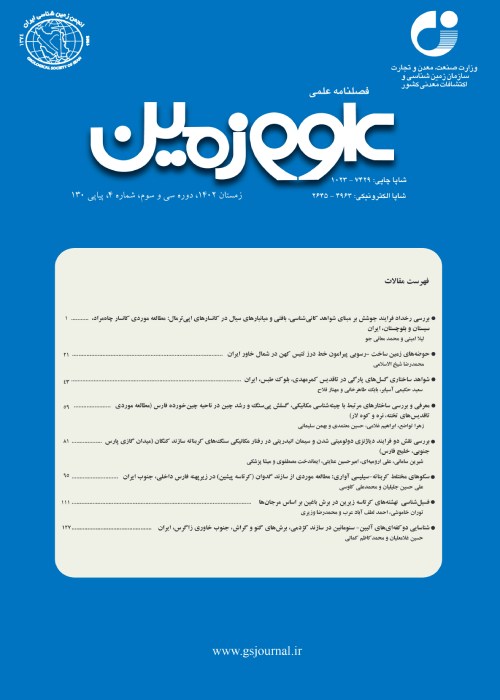Deciphering the stress field changes in Shahr-e-Babak area using brittle tectonic analysis
Author(s):
Article Type:
Research/Original Article (دارای رتبه معتبر)
Abstract:
In this paper a part of the Shahr-e-Babak area in NW-Kerman is studied, which is geologically located in Central Iran and Urumiyeh- Dokhtar Belt. The basin was strongly affected by compression in Miocene times, in which deformation is characterized by development of NW-SE trending fold and thrust belt. In this paper, we aim atdeciphering polyphase deformation and paleostress history of part of the Central Iran in the Shahr-e-Babak area, and that how various geological aspects may be related to a stress field that has been reoriented through time. Also, we indicate how the brittle deformation studies and paleostress analyses may contribute in the interpretations of the post-collisional tectonic evolution of this area. In this paper, by using systematic brittle tectonic analyses, including stress tensor inversion form fault-slip data, we decipher the succession of deformational events that resulted in present-day structures. Therefore, a statistical view of the brittle tectonic reconstructions taken as a whole leads one to better understand the relationships between the different stress fields and folding events that governed the history of compression in this area .The systematic reconstruction of brittle tectonic regimes led us to characterize an anticlockwise change in the main direction of compression through time. Thus, it can be seen that the late Cretaceous to late Miocene pre-folding N055° and N084° compression was followed by syn-folding N040° compression in the Miocene. The Miocene compression then continued into the Pliocene post-folding N029° direction, and changed afterward to the Pleistocene-Recent post-folding N003° direction. Although this general anticlockwise rotation of compression has probably been progressive through time, our data suggest three distinct stress regimes that (1) predate, (2) are contemporaneous with, and (3) post-date the more consistent compressional stress regime of the folding and thrusting process. According to this reconstruction, it is confirmed that many local right-lateral strikeslip faults were reactivated from NW-SE reverse faults in the Sahahr-e-Babak area of SW Central Iran .These results could properly support the hypothesis of a significant anticlockwise change in the movement direction of the Arabian plate with respect to the Eurasian plate and block rotation in Central Iran.
Keywords:
Language:
Persian
Published:
Geosciences Scientific Quarterly Journal, Volume:27 Issue: 105, 2017
Pages:
81 to 96
magiran.com/p1775354
دانلود و مطالعه متن این مقاله با یکی از روشهای زیر امکان پذیر است:
اشتراک شخصی
با عضویت و پرداخت آنلاین حق اشتراک یکساله به مبلغ 1,390,000ريال میتوانید 70 عنوان مطلب دانلود کنید!
اشتراک سازمانی
به کتابخانه دانشگاه یا محل کار خود پیشنهاد کنید تا اشتراک سازمانی این پایگاه را برای دسترسی نامحدود همه کاربران به متن مطالب تهیه نمایند!
توجه!
- حق عضویت دریافتی صرف حمایت از نشریات عضو و نگهداری، تکمیل و توسعه مگیران میشود.
- پرداخت حق اشتراک و دانلود مقالات اجازه بازنشر آن در سایر رسانههای چاپی و دیجیتال را به کاربر نمیدهد.
In order to view content subscription is required
Personal subscription
Subscribe magiran.com for 70 € euros via PayPal and download 70 articles during a year.
Organization subscription
Please contact us to subscribe your university or library for unlimited access!


